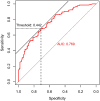Neoadjuvant chemoimmunotherapy cycle number selection for non-small cell lung cancer and clinical outcomes: a real-world analysis
- PMID: 37731645
- PMCID: PMC10508959
- DOI: 10.3389/fonc.2023.1200625
Neoadjuvant chemoimmunotherapy cycle number selection for non-small cell lung cancer and clinical outcomes: a real-world analysis
Abstract
Objectives: Neoadjuvant chemoimmunotherapy is the optimal choice in the treatment of NSCLC; however, the optimal number of therapeutic cycles remains unclear. The primary aim of this study was to determine the optimal number of neoadjuvant therapeutic cycles in NSCLC.
Methods: This study was a real-world clinical analysis that included patients who received neoadjuvant chemoimmunotherapy followed by surgery from January 2020 to August 2022. Patients were divided into two groups based on the number of therapeutic cycles: 2-cycle group and 3-4-cycles group. The primary endpoint was the major pathological response (MPR) rate.
Results: A total of 251 patients were included: 150 in the 2-cycle group and 101 in the 3-4-cycles group. Baseline characteristics were well-balanced between the groups. The MPR in the 2-cycle group was 57.3% and not significantly different from that of 57.4% in the 3-4-cycles group (p=0.529). Thirty-two patients (31.7%) in the 3-4-cycles group underwent surgery > 42 days after the final cycle of neoadjuvant therapy, significantly more than the 24 patients (16.0%) in the 2-cycle group (p=0.003). The incidence of adverse events related to neoadjuvant therapy was higher in the 3-4-cycles vs 2-cycle groups (72.3% versus 58.0%, respectively; p=0.021), while the 2-cycle group had a higher rate of postoperative morbidities (28.0% versus 12.9%, respectively; p=0.004). Additionally, for patients with ≤ 44.2% regression in diameter on computed tomography after two cycles of treatment, the MPR rate was higher in the 3-4-cycles vs 2-cycle group (47.3% versus 29.9%, respectively; p=0.048). For cases with programmed death-ligand 1 expression, regarding tumor proportion score ≤ 10%, 3-4 cycles of neoadjuvant treatment increased the MPR rate compared with 2 cycles (37.5% versus 9.5%, respectively; p=0.041).
Conclusion: Our data support the positive role of chemoimmunotherapy in the neoadjuvant treatment of NSCLC. Extending to 3-4 cycles instead of 2 cycles of neoadjuvant chemoimmunotherapy may improve the safety of surgery and result in a lower incidence of postoperative morbidities; however, the MPR rate may not increase significantly. CT re-evaluation during treatment and PD-L1 expression at initial diagnosis are potential indicators to guide the choice of the number of therapeutic cycles.
Keywords: adverse events; morbidity; neoadjuvant chemoimmunotherapy; non-small cell lung cancer; treatment cycles.
Copyright © 2023 Zhang, Guo, Jia, Wang, Wu, Chen, Li, Yang, Li, Wang and Xiao.
Conflict of interest statement
The authors declare that the research was conducted in the absence of any commercial or financial relationships that could be construed as a potential conflict of interest.
Figures






Similar articles
-
Comparison of neoadjuvant chemoimmunotherapy and chemotherapy alone for resectable stage III non-small cell lung cancer: a real-world cohort study.Front Immunol. 2023 Dec 22;14:1343504. doi: 10.3389/fimmu.2023.1343504. eCollection 2023. Front Immunol. 2023. PMID: 38187385 Free PMC article.
-
Neoadjuvant immunotherapy or chemoimmunotherapy in non-small cell lung cancer: a systematic review and meta-analysis.Transl Lung Cancer Res. 2022 Feb;11(2):277-294. doi: 10.21037/tlcr-22-75. Transl Lung Cancer Res. 2022. PMID: 35280319 Free PMC article.
-
A real-world comparison between neoadjuvant chemoimmunotherapy and chemotherapy alone for resectable non-small cell lung cancer.Cancer Med. 2023 Jan;12(1):274-286. doi: 10.1002/cam4.4889. Epub 2022 May 27. Cancer Med. 2023. PMID: 35621048 Free PMC article.
-
Efficacy and safety of neoadjuvant immunotherapy protocols and cycles for non-small cell lung cancer: a systematic review and meta-analysis.Front Oncol. 2024 Jan 16;14:1276549. doi: 10.3389/fonc.2024.1276549. eCollection 2024. Front Oncol. 2024. PMID: 38292925 Free PMC article.
-
A systematic review and meta-analysis of neoadjuvant chemoimmunotherapy in stage III non-small cell lung cancer.BMC Pulm Med. 2022 Dec 29;22(1):490. doi: 10.1186/s12890-022-02292-5. BMC Pulm Med. 2022. PMID: 36582007 Free PMC article.
Cited by
-
Neoadjuvant and Adjuvant Immunotherapy in Resectable NSCLC.Cancers (Basel). 2024 Apr 23;16(9):1619. doi: 10.3390/cancers16091619. Cancers (Basel). 2024. PMID: 38730571 Free PMC article. Review.
-
Neoadjuvant immunotherapy for non-small cell lung cancer: Opportunities and challenges.Chin Med J Pulm Crit Care Med. 2024 Dec 12;2(4):224-239. doi: 10.1016/j.pccm.2024.11.003. eCollection 2024 Dec. Chin Med J Pulm Crit Care Med. 2024. PMID: 39834585 Free PMC article. Review.
-
Potential predictors of the pathologic response after neoadjuvant chemoimmunotherapy in resectable non-small cell lung cancer: a narrative review.Transl Lung Cancer Res. 2024 May 31;13(5):1137-1149. doi: 10.21037/tlcr-24-142. Epub 2024 May 24. Transl Lung Cancer Res. 2024. PMID: 38854945 Free PMC article. Review.
-
Neoadjuvant immunotherapy for NSCLC: superior combination strategies, optimal treatment cycles, and predictive indicators from a Bayesian meta-analysis.Front Immunol. 2025 Mar 27;16:1548665. doi: 10.3389/fimmu.2025.1548665. eCollection 2025. Front Immunol. 2025. PMID: 40213564 Free PMC article.
-
Is adjuvant immunotherapy necessary after neoadjuvant chemoimmunotherapy in patients with resectable stage III NSCLC? A two-center real-world study.Cancer Immunol Immunother. 2025 Jul 21;74(8):273. doi: 10.1007/s00262-025-04130-z. Cancer Immunol Immunother. 2025. PMID: 40690022 Free PMC article.
References
-
- Provencio M, Serna-Blasco R, Nadal E, Insa A, García-Campelo MR, Casal Rubio J, et al. . Overall Survival and Biomarker Analysis of Neoadjuvant Nivolumab Plus Chemotherapy in Operable Stage IIIA Non-Small-Cell Lung Cancer (NADIM phase II trial). J Clin Oncol (2022) 40(25):2924–33. doi: 10.1200/JCO.21.02660 - DOI - PMC - PubMed
LinkOut - more resources
Full Text Sources
Research Materials

